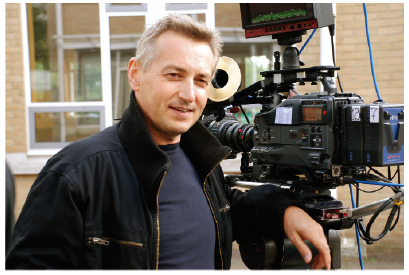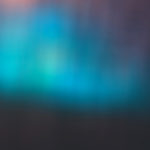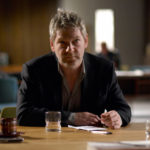
Skins
Posted on Dec 1, 2008 by Alex Fice
Your mother wouldn’ t like it but Channel 4’s SKINS is a hit with an international market. Now HD is part of the story. We talked to DP Nick Dance about how he became part of it.There is a certain migration happening from the South East to the South West of England and it’s not just to do with social and economic reasons. For the TV business going West can be the difference between making something to budget and schedule and not. Skins, Channel 4’s infamous youth drama, shoot all around the city, taking advantage of the polar opposites of Clifton’s Georgian affluence and the housing estates of Easton. Unlike London shooting in the city of Bristol doesn’t garner the attention of the Police or even much attention from the public, (especially now as Skins is proudly a Bristolian production). Crews and gear are cheaper and of course there is no congestion charge.
Skins is a youth drama that to a degree is written by people of the same age as those who act in it. The decision to form the Skins Writers Workshop may have been the inspired move that set the series apart from the Hollyoaks type of angst ridden youth drama but it is also the in-built assembly line of young actors, many hugely inexperienced, that possibly gives the programme that edge. It is dealing with this combustible mix of raw writing and raw acting that demands a firm and experienced hand on the lens.
The programme is now shooting it’s third series and has been bolstered by a number of ringing endorsements from the industry, BAFTA and RTS nominations including ones for photography and lighting and further to the plaudits a possible US version. The third series is the first to start completely shooting in high definition but not for any particular ‘future proofing’ reason, the cameras are just better and reasonable to hire. Perhaps finally we have reached the point where the decision to shoot HD doesn’t mean poring over the business plan to find the budget or using a foreign sale to red light the HD equipment list.
 Nick Dance with one of the directors of Skins, Harry EnfieldThe DoP for the third and second series and some of the first is Nick Dance, another migratory bird as he has set up house and home somewhere between London and Bristol. Nick’s huge experience in documentaries, film, TV drama and commercials suited Skins as they wanted a film look. Nick has shot Sorted which was his first go at an HD drama: “The producer had seen Bleak House and was impressed with the look and wanted to try HD for Sorted. I was approached and decided to take on the challenge as I felt HD was making fast inroads to film and TV production.” After considerable testing with the camera set-up, filtration and lighting they started the shoot. “For Skins I had enough experience shooting HD to know it’s limitation, but was able to combine my film knowledge in composition and lighting to give the producers what they wanted.”
Nick Dance with one of the directors of Skins, Harry EnfieldThe DoP for the third and second series and some of the first is Nick Dance, another migratory bird as he has set up house and home somewhere between London and Bristol. Nick’s huge experience in documentaries, film, TV drama and commercials suited Skins as they wanted a film look. Nick has shot Sorted which was his first go at an HD drama: “The producer had seen Bleak House and was impressed with the look and wanted to try HD for Sorted. I was approached and decided to take on the challenge as I felt HD was making fast inroads to film and TV production.” After considerable testing with the camera set-up, filtration and lighting they started the shoot. “For Skins I had enough experience shooting HD to know it’s limitation, but was able to combine my film knowledge in composition and lighting to give the producers what they wanted.”
Nick was originally approached to shoot the last two episodes of Skins Series One, one of which was the episode that attracted all the craft nominations. Nick has made his name with documentaries early in his career (see sidebar ‘Nick’s Shooting History’) and brings that experience to bear on Skins: “In all television drama certainly in the UK, as ever, the budgets are reduced and the producers are looking for people who are a bit more flexible with the way they approach it. The old school DoPs could have commanded as much time as they needed to light scenes but now everyone wants the same quality, there are no excuses. So there is the pressure of getting the quality on budget and on time. Chris Clough, Skins’ producer, does appreciate that I’m from a documentary background and suddenly having that experience is an important part of drama because as a ‘doco’ cameraman you’d turn up to somewhere in the middle of Africa maybe and make something of it. Today there is less time for recces and quite often we turn up at some locations without having seen it before. I like thinking on my feet, working on the day and get inspired from that.
“That way of working certainly works for something like Skins which is spontaneous, lively, light but it has it’s dark moments too. But we do try and keep an ‘up’ feel to it. But even on features you don’t get the time you used to get. But of course now cameras are much better, video cameras will handle the contrast. When I started you had 100 ASA film, you had an Ikegami which was probably less than that equivalent to 80. Now we have 500 ASA film stocks, we have video cameras with at least 5, 6, 700 ASA equivalent.
“Bad Girls was my first proper drama which was shot in the late Nineties. That was shot on DigiBeta and the crew was bigger with tighter time constraints than I was used to. The drama was shot on a big set based at Three Mills in London. I was seen as documentary film maker who possibly couldn’t handle the lighting and the pressure. But my philosophy has always been keep it simple, just because you’ve got a truck full of lights on a drama doesn’t mean you have to use them all. You really just don’t have time to use a lot of lights and actually I just think it becomes more complicated, you get more shadows. I used to do a lot of ‘available light’ stuff on documentaries, you appreciate window sources and where the light is coming from. From a lot of drama that still is a good starting point, let see how the scene is playing with natural light sources. If you’re doing something ‘fantasy’ you can do something else, do something high lit.“ Nick calls Skins ‘heightened naturalism’ which means using that documentary technique but maybe putting in some more warmth and some more light. That doesn’t have to mean hand held as there isn’t much of that in the series.
 DoP of Skins Nick DanceLighting a scene in Skins is a matter of quick decision making: “I like the spontaneity on-set especially with the younger people we have here. Once they’ve rehearsed I’ve got my lighting concept in my mind and you set the lighting up initially. You don’t use all those lights you’ve rigged but it’s all ready in position so you can move around quickly. It’s documentary techniques again but you can shoot quickly before the actors all go off the boil. These inexperienced actors do put a lot of energy in to the first and second take”. You could say that this quickness of working and the heightened reality look is the heart of what Nick brings to Skins.
DoP of Skins Nick DanceLighting a scene in Skins is a matter of quick decision making: “I like the spontaneity on-set especially with the younger people we have here. Once they’ve rehearsed I’ve got my lighting concept in my mind and you set the lighting up initially. You don’t use all those lights you’ve rigged but it’s all ready in position so you can move around quickly. It’s documentary techniques again but you can shoot quickly before the actors all go off the boil. These inexperienced actors do put a lot of energy in to the first and second take”. You could say that this quickness of working and the heightened reality look is the heart of what Nick brings to Skins.
But what about HD? Nick’s first real experience of it was with the TV series about Postmen in Manchester, Sorted and that series’ producer, Steve Lightfoot, was certainly sharing the pioneering spirit: “The considerations I had to make were about cost, as, like everyone else, our budget was tight, and also the look of the show. Sorted was a very naturalistic piece of drama – real people, real lives. Ultimately HD worked for both. It’s a slightly different look to film, cleaner and the depth of field goes on forever in the wides, but incredibly rich. We wanted a very natural world, but a warm one, somewhere our audience want to spend time and we got that. The right camera set up by Nick Dance meant the sharp edges were taken off, so it didn’t have any kind of ‘video’ look. HD is a fantastic tool in the right hands.”
Nick’s experience with HD was similar: “There’s a lot of snobbery with HD, a lot of producers thought ‘It’s HD that means 35mm feature disciplines, we’ll only use feature film cameramen to do it’. Actually many of those guys hadn’t got any video experience at all so they got in to all sorts of problems. I certainly think the experience of tape and film is a very valuable grounding for shooting HD.”
Skins series two shot on the Sony 750 and the new series on the Sony 900R. He had done various tests on the cameras and actually showed some of the 750 Skins footage at the recent BSC event in Cardiff: “It was a beach scene which I think really pushed the envelope, the sun was setting behind. A few people turned their nose up on the 750 and I certainly think using the 900R, it is a better camera but what we did get from the 750 was really quite amazing. “The contrast range with the newer cameras is much better, progressive scan is always useful, I remember with Bad Girls we put it through a film effect and de-interlaced afterwards. They tried that with Casualty but that was a disaster because people got used to the look.
“HD is another tool in the toolbox, you get a script and you decide how it should be done. You shouldn’t force a format on to the story. Skins is perfect for HD, its bright and vibrant but perhaps you wouldn’t want that for a period drama although Bleak House had many fans. For a lot of DoPs it is more of a struggle with HD because you have this slightly reduced contrast range and things like shooting against a window or in sunshine is a bit more of a struggle. For those high contrast situations yes you do need to put more light in which then maybe becomes a little bit forced, it may look a bit lit.”
Skins decision to go with high definition was purely one of better cameras, all the R&D for cameras is going into the high definition models and so quite naturally they’re better. “The new cameras are easier to handle, have more contrast range. Many producers go on about how it is much slower to shoot tape, they’re thinking about the video village, the cables things like that. What I tend to do these days is to get rid of all of that and get back to film techniques of shooting with HD. In other words perhaps we’ll have one BNC from the camera, the sounds always on a separate track, DAT or hard drive. We have one 17inch monitor, we have an Astro-type monitor on the camera and that’s it. I do my own operating generally because that’s the way I’ve worked from my documentary days. I like to work on the set close to the action. With Bad Girls sometimes I felt that I was 100ft away and a bit remote from it. Once you get used to the viewfinders and the way they respond I think you can light successfully with HD. With 2/3in cameras there is this back focus issue but as long as you’re aware of it that shouldn’t be a problem. Generally the newer viewfinders can see it.
“With something like the Genesis or the D20 you don’t have that problem, I haven’t tested the RED yet. They are better in as much as they take film lenses and have the 35mm depth of field. Although in drama you don’t necessarily want to see everything so far back, so you achieve more shallow depth of field with lower lighting with a wide aperture, which gives you the focus issues, maybe slightly long lenses or you have to go for the Pro35 approach. We don’t use the adapter on Skins because you’re losing two stops of light and you can get a flaring on the highlights. We don’t have time for re-shoots.” Lenses for Skins are usually of the film style type which are “better for the focus pullers as they have more travel on the focus so they’re more accurate”. They’re using two wide and tight zooms, and a limited amount of primes.
Lower drama budgets and increased shooting pressure all seem tailor made for those DPs who have seen it all before in the documentary arena. Perhaps Nick Dance has the ideal combination of experience that is now coming to bear on this budget obsessed industry still keen on the best possible look.
Nick first found fame for his cinematography when at the age of 15 he won a BBC annual film competition – pictured right is Nick setting up a shot with a BBC film crew.
After film school he got a job at the BBC cutting rooms. Although he really wanted to get behind the camera his experience cutting film was invaluable to him.
For the next few years he worked with an ex BBC cameraman which took them all over the world doing drama and documentary. When Channel 4 started he worked as a camera assistant and got his big break when he was asked to shoot a series of documentaries. He moved on to shooting on series like Robin of Sherwood and Monocled Muntineer.
For the next 10 years he continued to shoot documentaries for BBC, ITV and Channel 4 including one about Simon Weston the Falklands hero.







